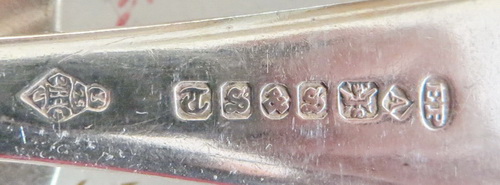Hi, I have used numerous websites and books to try to figure out some info. about this set of forks but I have come up with nothing. I have read that many EP items had hallmarks that meant nothing at all and were just for “show” but I hoped that maybe by posting here someone more knowledgeable than myself might be able to tell me if the hallmarks mean anything (such as age or where they are from).
[/img]

In general marks on electroplate do have meaning. However this is normally limited to the maker’s name and their estimate of the plating quality. You have an additional piece of information - the kite-shaped mark is a design registration mark and gives the exact date when the design was registered. This provides an earliest possible manufacturing date. Your picture is not clear enough to read the the details but you can work it out for yourself by reference to the tables here.
Moving along the fork we have the initials of the manufacturing company, TS&S. Unfortunately I cannot find this maker listed in any of my references. The next mark is the company’s trade mark. “A” is almost certainly an indication of the plating quality. Finally EP, of course, means electroplate.
My final point is that the marks are not, strictly speaking, hallmarks, which are only found on precious metal objects and are applied by an inedpendent assay office and not the manufacturer.
That is very interesting and informative. Thank you so much. I have used a magnifier on the design registraton mark but I am still unable to tell what is says. I will have a look at the link you have given me and see what I can find. Many thanks to you. 
I have had a super close and careful look through all the forks and one of them was a little easier to make out than the others,
It looks like the number beneath the letter I at the top is 28, there is the letter “E” on the right side of the diamond, the number “2” on the left side and what looks like the letter “M” at the bottom.
At the risk of sounding completely stupid I was a bit confused about the 2 tables of the registry date numbers page. Is it saying that if the mark on the right side of the diamond is a letter, then it represents the year and if it is a number then it represents the day?
Also, with regards to the year, you mentioned previously that the year is the earliest possible date so not necessarily the date of these particular forks?
A number below the “I” shows that you should use the key diagram on the right which is for dates between 1868 and 1883. So 28 is the 28th day of the month, E is 1881, 2 is the parcel number (we can ignore this), and M is June. Thus the design of the forks was registered on 28 June 1881. Having made the registration the company could then start making them and would probably continue to do so for several years. This is why the manufacturing date would not normally be earlier than the registration date.
Do you think that it would be right to say that these forks then date within approximately 5 years from the registration date or could it be that they still made the design for example, 50 years later?
and one more question…
You mentioned the “TS&S” as being the makers. I did a little internet search and found the following on a site about silver makers:
“TS & S (T Smith & Sons [ G ] ) 19th c./2nd half”
so I am wondering, would a silvermaker sometimes venture off a make EP items and therefore this could be the makers of my set of forks?
Thank you very much.
5 years is probably too short a period, but 50 is probably too long. I’m sure that if TS&S had been in business that long they would have appeared on the sites where I was looking through sheer quantity. T Smith & Sons of Glasgow cannot be ruled out, but I’m sure there are other possibilities (although none spring to mind). The larger silversmithing companies would almost always have had electroplate in their catalogues in order to satisfy demand from those who could not afford solid silver.
thank you very much. I really appreciate your help with this. 


